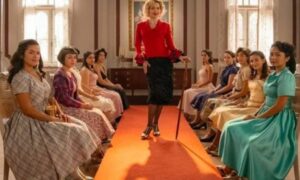Kate Middleton and Prince William’s decision to enroll their children at Marlborough College marks a significant shift in the history of the British monarchy. Traditionally, heirs to the throne have attended Eton College, an all-boys boarding school that has educated generations of royals, including Prince William and his brother, Prince Harry. By opting for a coeducational institution, the Princess of Wales is breaking with a centuries-old tradition and introducing a new educational model for the future monarchs, prioritizing a diverse learning environment aligned with modern values of inclusion. This decision not only represents a change in the royal family’s educational approach but also signals a strategic adaptation of the monarchy to contemporary social realities.
Marlborough College, located in Wiltshire, is one of the most prestigious institutions in the UK, known for its rigorous academic standards and extensive extracurricular activities. Founded in 1843, the school initially catered exclusively to aristocratic boys but became coeducational in 1968, pioneering a balanced academic environment. Kate Middleton attended the institution between the ages of 13 and 18, and her positive experience likely played a role in the decision to enroll George, Charlotte, and Louis in the same school.
Eton College, on the other hand, continues to uphold its tradition as an exclusive boys-only boarding school, following an educational model that, despite its esteemed reputation, no longer aligns with the modern principles of gender equality and diversity that Kate and William wish for their children. By choosing Marlborough College, the royal couple demonstrates a commitment to an education that is both inclusive and adapted to the evolving needs of society.

A Paradigm Shift in Royal Heirs’ Education
Sending the royal children to Marlborough College marks a significant departure from the British royal family’s long-standing educational traditions. For centuries, future monarchs were strictly educated in private settings, often at home with specialized tutors. Queen Elizabeth II, for instance, was educated privately, receiving lessons in constitutional history and politics. King Charles III was the first heir to attend a boarding school, studying at Gordonstoun in Scotland, known for its academic rigor and strict discipline.
With William and Harry, the royal family returned to Eton College, one of the world’s most prestigious institutions, which has produced British political and business leaders. Kate and William’s decision to send their children to Marlborough College suggests a new approach focused on raising heirs who are prepared for the challenges of the 21st century. The education at Marlborough emphasizes critical thinking, innovation, and a balance between tradition and modernity.
Key Features of Marlborough College That Influenced the Royal Decision
- High-quality academic education covering mathematics, sciences, literature, and arts
- Coeducational model promoting gender equality and diversity
- Encouragement of critical thinking and creativity
- Extensive extracurricular and sports programs
- Leadership development across various fields
- Prestige and tradition ensuring a high-level education
The annual tuition fee at Marlborough College is approximately £59,000 per student, a significant investment to ensure the royal children receive a comprehensive education suited to the demands of the modern world.
The Importance of Coeducational Learning for Royal Children
Kate Middleton’s choice of a mixed-gender school reflects a growing trend among elite families and society in general. Coeducation offers numerous advantages beyond academic learning, preparing students for a more diverse world.
Key benefits of coeducational schools include:
- Better preparation for the workforce – Boys and girls learning together develop social skills essential for future careers.
- Interpersonal development – Sharing experiences fosters communication and understanding of different perspectives.
- Improved emotional balance – Studies show that mixed-gender educational environments contribute to healthier emotional development.
- Greater inclusion and diversity – Exposure to various social and economic backgrounds broadens students’ worldviews.
- Breaking stereotypes – Daily interaction between boys and girls helps challenge traditional gender roles and reinforce equal opportunities.
With this decision, Kate and William show their commitment to raising children who, beyond academic excellence, will be prepared to take on leadership roles in an ever-changing world.
The Evolution of Education in the British Royal Family
Education for British royal family members has evolved significantly over the centuries. Initially, princes and princesses were tutored within palace walls, focusing on history, politics, and royal etiquette. In the 20th century, the monarchy began embracing formal schooling for its heirs.
- Queen Elizabeth II (1926-2022) – Privately educated at home with a focus on constitutional history and governance.
- King Charles III (born 1948) – First heir to attend a boarding school, studying at the strict and discipline-oriented Gordonstoun.
- Prince William and Prince Harry – Both studied at Eton College, maintaining the aristocratic tradition of elite British education.
Now, Kate Middleton is setting a new precedent by choosing a more inclusive and modern educational model for her children.
Impact of the Decision on the British Monarchy
The change in educational choice for George, Charlotte, and Louis could influence future generations of royals and even other aristocratic families in the UK. The selection of Marlborough College represents a departure from elite male-only institutions and a move towards contemporary values where gender equality and diversity are key priorities.
This move also reinforces Kate and William’s intention to provide their children with as normal an upbringing as possible, balancing royal responsibilities with everyday childhood experiences familiar to many British families.
A Growing Trend Among European Monarchies
Other European royal families have also begun embracing more flexible and inclusive education models for their heirs. Countries such as Sweden, Norway, and Denmark have moved away from traditional all-boys schools in favor of mixed-gender and international education systems. This reflects the need to prepare future leaders for global challenges by emphasizing adaptability, communication, and innovation.
What’s Next for Kate and William’s Children’s Education?
Currently, George, Charlotte, and Louis attend Lambrook Preparatory School in Berkshire, a prestigious preparatory school. The transition to Marlborough College is expected in the coming years as they advance to secondary education.
The choice of a coeducational school reinforces the royal family’s commitment to a modern education based on inclusion and excellence. The impact of this decision may shape the future of British royal education, setting a new standard for generations to come.

Kate Middleton and Prince William’s decision to enroll their children at Marlborough College marks a significant shift in the history of the British monarchy. Traditionally, heirs to the throne have attended Eton College, an all-boys boarding school that has educated generations of royals, including Prince William and his brother, Prince Harry. By opting for a coeducational institution, the Princess of Wales is breaking with a centuries-old tradition and introducing a new educational model for the future monarchs, prioritizing a diverse learning environment aligned with modern values of inclusion. This decision not only represents a change in the royal family’s educational approach but also signals a strategic adaptation of the monarchy to contemporary social realities.
Marlborough College, located in Wiltshire, is one of the most prestigious institutions in the UK, known for its rigorous academic standards and extensive extracurricular activities. Founded in 1843, the school initially catered exclusively to aristocratic boys but became coeducational in 1968, pioneering a balanced academic environment. Kate Middleton attended the institution between the ages of 13 and 18, and her positive experience likely played a role in the decision to enroll George, Charlotte, and Louis in the same school.
Eton College, on the other hand, continues to uphold its tradition as an exclusive boys-only boarding school, following an educational model that, despite its esteemed reputation, no longer aligns with the modern principles of gender equality and diversity that Kate and William wish for their children. By choosing Marlborough College, the royal couple demonstrates a commitment to an education that is both inclusive and adapted to the evolving needs of society.

A Paradigm Shift in Royal Heirs’ Education
Sending the royal children to Marlborough College marks a significant departure from the British royal family’s long-standing educational traditions. For centuries, future monarchs were strictly educated in private settings, often at home with specialized tutors. Queen Elizabeth II, for instance, was educated privately, receiving lessons in constitutional history and politics. King Charles III was the first heir to attend a boarding school, studying at Gordonstoun in Scotland, known for its academic rigor and strict discipline.
With William and Harry, the royal family returned to Eton College, one of the world’s most prestigious institutions, which has produced British political and business leaders. Kate and William’s decision to send their children to Marlborough College suggests a new approach focused on raising heirs who are prepared for the challenges of the 21st century. The education at Marlborough emphasizes critical thinking, innovation, and a balance between tradition and modernity.
Key Features of Marlborough College That Influenced the Royal Decision
- High-quality academic education covering mathematics, sciences, literature, and arts
- Coeducational model promoting gender equality and diversity
- Encouragement of critical thinking and creativity
- Extensive extracurricular and sports programs
- Leadership development across various fields
- Prestige and tradition ensuring a high-level education
The annual tuition fee at Marlborough College is approximately £59,000 per student, a significant investment to ensure the royal children receive a comprehensive education suited to the demands of the modern world.
The Importance of Coeducational Learning for Royal Children
Kate Middleton’s choice of a mixed-gender school reflects a growing trend among elite families and society in general. Coeducation offers numerous advantages beyond academic learning, preparing students for a more diverse world.
Key benefits of coeducational schools include:
- Better preparation for the workforce – Boys and girls learning together develop social skills essential for future careers.
- Interpersonal development – Sharing experiences fosters communication and understanding of different perspectives.
- Improved emotional balance – Studies show that mixed-gender educational environments contribute to healthier emotional development.
- Greater inclusion and diversity – Exposure to various social and economic backgrounds broadens students’ worldviews.
- Breaking stereotypes – Daily interaction between boys and girls helps challenge traditional gender roles and reinforce equal opportunities.
With this decision, Kate and William show their commitment to raising children who, beyond academic excellence, will be prepared to take on leadership roles in an ever-changing world.
The Evolution of Education in the British Royal Family
Education for British royal family members has evolved significantly over the centuries. Initially, princes and princesses were tutored within palace walls, focusing on history, politics, and royal etiquette. In the 20th century, the monarchy began embracing formal schooling for its heirs.
- Queen Elizabeth II (1926-2022) – Privately educated at home with a focus on constitutional history and governance.
- King Charles III (born 1948) – First heir to attend a boarding school, studying at the strict and discipline-oriented Gordonstoun.
- Prince William and Prince Harry – Both studied at Eton College, maintaining the aristocratic tradition of elite British education.
Now, Kate Middleton is setting a new precedent by choosing a more inclusive and modern educational model for her children.
Impact of the Decision on the British Monarchy
The change in educational choice for George, Charlotte, and Louis could influence future generations of royals and even other aristocratic families in the UK. The selection of Marlborough College represents a departure from elite male-only institutions and a move towards contemporary values where gender equality and diversity are key priorities.
This move also reinforces Kate and William’s intention to provide their children with as normal an upbringing as possible, balancing royal responsibilities with everyday childhood experiences familiar to many British families.
A Growing Trend Among European Monarchies
Other European royal families have also begun embracing more flexible and inclusive education models for their heirs. Countries such as Sweden, Norway, and Denmark have moved away from traditional all-boys schools in favor of mixed-gender and international education systems. This reflects the need to prepare future leaders for global challenges by emphasizing adaptability, communication, and innovation.
What’s Next for Kate and William’s Children’s Education?
Currently, George, Charlotte, and Louis attend Lambrook Preparatory School in Berkshire, a prestigious preparatory school. The transition to Marlborough College is expected in the coming years as they advance to secondary education.
The choice of a coeducational school reinforces the royal family’s commitment to a modern education based on inclusion and excellence. The impact of this decision may shape the future of British royal education, setting a new standard for generations to come.







